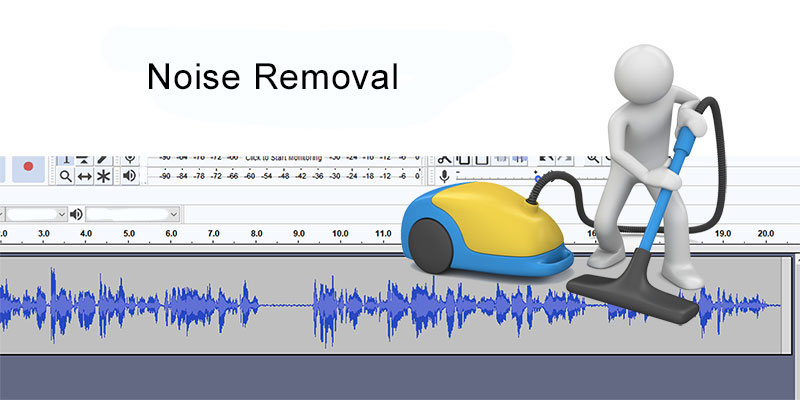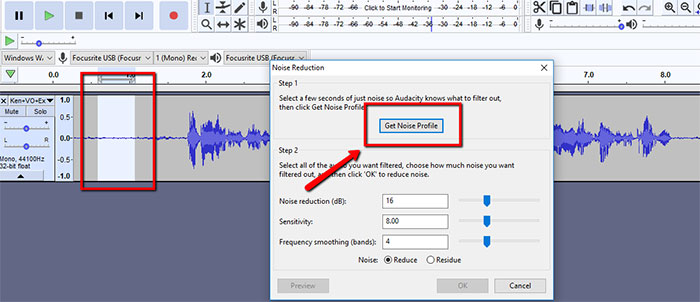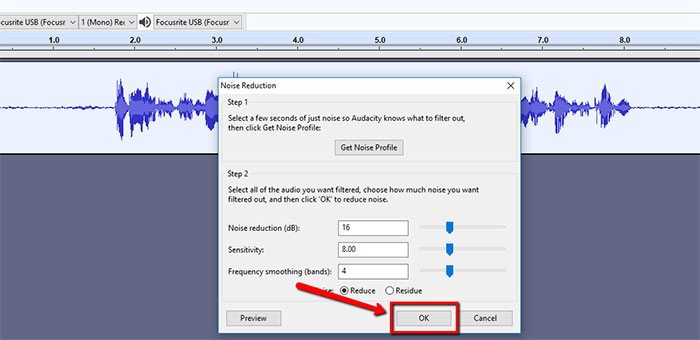
Want to know how to get rid of background noise in your audio recordings? Here is an easy and free way to do it using Audacity audio software.
Unless you are lucky enough to be able to record audio in a very quiet space, you will probably have some background noise in your audio recordings. The most common types of noise are computer fans, A/C or heater blowers, or hiss coming from the microphone itself.
If you are recording your voice all by itself, for a voiceover job, podcast, or video narration, any background noise will be distracting and make your recording sound less than professional.
The good news is that there is a quick and easy way to remove this background noise using Noise Reduction tools in just about any audio recording software program. Yes, you can get rid of noise AFTER you’ve already recorded it! That process is universally called “noise reduction.”
I’ll show you how to get rid of background noise using Audacity, which is free. But the process works pretty much the same way in any program.
For some information on the most current and much better noise reduction tool in Audacity, check out our post – New Noise Reduction Tool In Audacity.
Record Some Silence At The Beginning
In order for Audacity to remove noise from your voice recording, it needs to know what “noise” sounds like. So the very first thing you need to do is find a section of your recording where there is no voice, or breath, or anything EXCEPT noise. I recommend recording 3-5 seconds of silence at the beginning of your recording session so that you can record only noise.
During this few seconds before you start speaking, make sure you don’t take any audible breaths or make any other noises like lip-smacking or sniffing or bumping against the microphone, etc. It is crucial that you record a sample of the steady sound of the noise in your room and/or mic.
Choose a Sample of ONLY Noise
After you have finished recording, highlight (click and drag) at least half a second of JUST background noise. IMPORTANT: Make ABSOLUTELY sure you do not highlight any breaths or bumps or any sounds other than the steady noise in the room or mic. And the most important thing of all is to never, EVER (getting the idea? :-)) highlight any part of your voice during this step. This is where you are telling Audacity what you want removed. So if there are any breaths or voice traces in this selection, Audacity will try to remove those. And that would sound terrible.
Believe it or not, this is really common. It’s probably the most common mistake people make when trying to figure out how to get rid of background noise.
Feed Audacity The “Noise Profile”
Once you have at least half a second of ONLY background noise highlighted, it’s time to feed that to Audacity.
Click “Effect” in the Audacity Menu. In the drop-down, choose “Noise Reduction.” In the window that pops up, click on the button that says “Get Noise Profile.” See the picture below.

Once you click “Get Noise Profile” the Noise Reduction window will close. That means Audacity now knows what to remove from ALL your audio. You have defined “noise” for Audacity – at least for this recording.
Now Select Your Entire Recording
It’s time to apply noise reduction. But first you need to select all your audio. So click on “Select” in the Audacity menu, and then choose “All” from the menu. The standard “ctrl-A” (or cmd-A on a Mac) also works. You can also just double-click anywhere on your audio file.
However you do it, make sure all your audio is now selected.
Open Noise Reduction Effect Again
Now once again open Noise Reduction (Effect/Noise Reduction). But this time DO NOT CLICK “Get Noise Profile” again. This is very important. Simply click the OK button.

The Noise Should Now Be Gone!
Now Here Is a Video of the Process
Here is a video showing the whole process, which took a LOT longer to describe than it takes to actually do. Be sure to WEAR HEADPHONES when listening to this video so you can hear the background noise in the first part of the video (before it gets removed)!
Avoiding The “Swirlies”
For the best possible results, the noise should not be too loud to begin with. If there is too much noise, it will be very difficult for Audacity (or any software) to separate noise from the GOOD audio – your voice, or whatever you recorded. The usual result of trying to remove too much noise is that the audio left behind sounds weird. It often sounds like the audio is under water. So people often call this weird sound “the swirlies,” because it sounds a bit like swirling water. So try to minimize the noise before you record as much as possible.
Another potential cause of weird sounding after-effects of noise reduction is if you accidentally picked up some of your own voice in the noise profile sample at the beginning of this process. That is why I put so many warnings of why it was so important to make sure you highlight ONLY the steady background noise. No breaths, no vocal sounds, etc.
If the background noise is consistent and steady and not too loud compared to the voice, noise reduction should work perfectly.